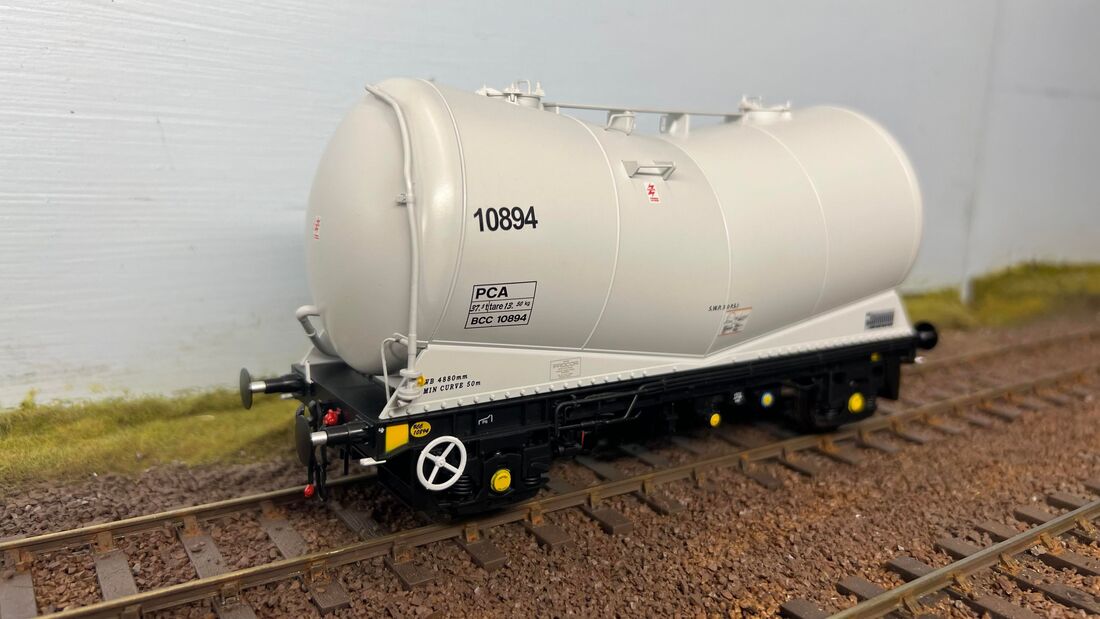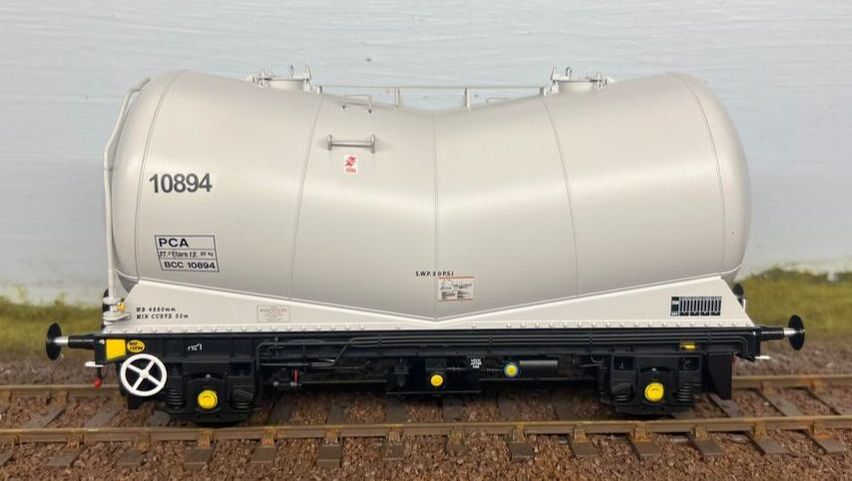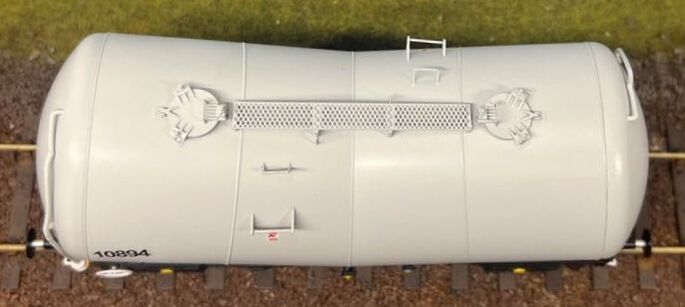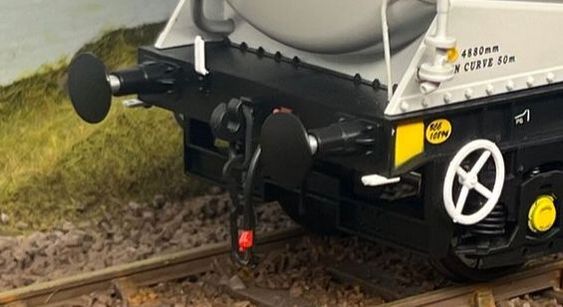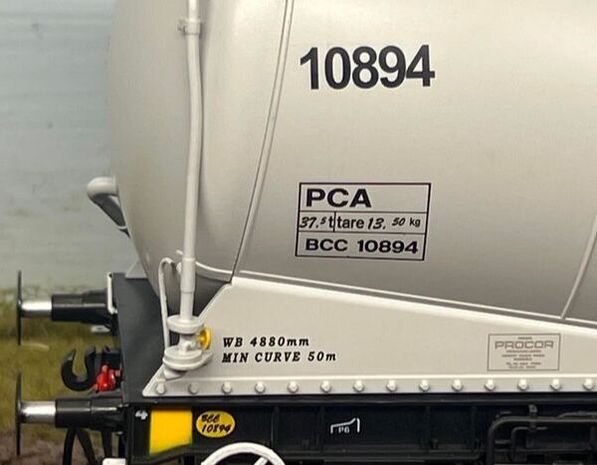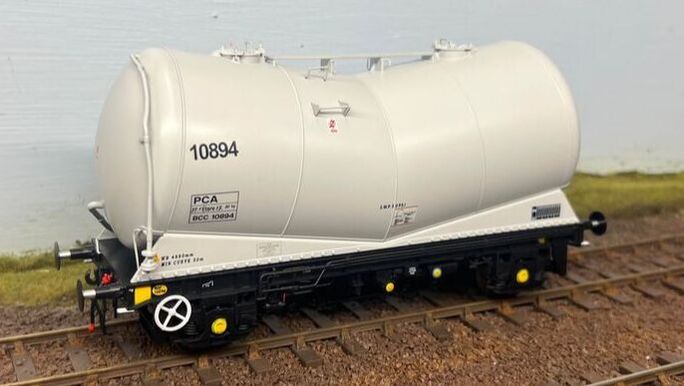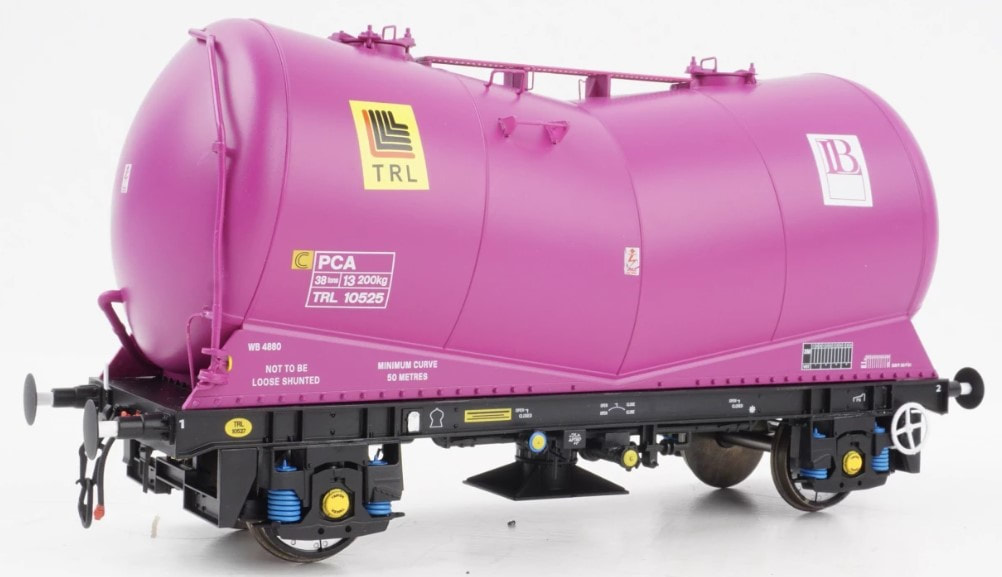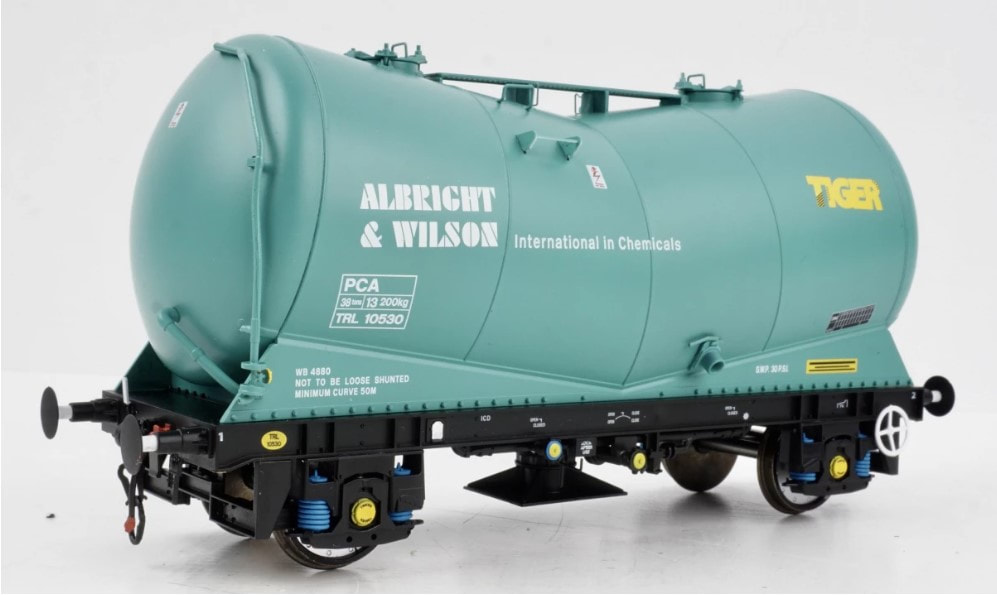37707 Perth on the 9th March 1991 with a mixed train including a number of PCA wagons. Image courtesy of Alan Tait.
History
The design follows the principles first introduced by the air pressurised family of wagons, more commonly known as ‘Presflo’. This is where compressed air is used as a ‘liquefier’ for solid powders. The PCA designation covers a multitude of wagons designs including the depressed centred versions more commonly known as “Chevron” or “Vee Tank” wagons These are most commonly associated with the movement of cement, but they have also been used for a variety of other powdered materials. Improvements in the way the pressurisation systems operated meant that the depressed centre was no longer required. Later PCA models were built parallel bodied tanks. A number of PCA wagons were built to the French design with sloping ends.
The familiar Vee shaped tanks have been part of the railway scene since their introduction in the late 1960’s. Now, after over 50 years of operation the design has entered the twilight of their careers.
The original ‘Vee Tank’ prototype wagon was built by Powell Duffryn in 1966, and featured long links and tapered leaf spring suspension. The design was selected by Allied Portland Cement Manufacturers (APCM), more commonly known as “Blue Circle”, who ordered 50 wagons from Metro-Cammell in 1966.
The initial batch of wagons were built to the prototype design. Featuring loading/unloading equipment attached to the solebar in the centre of the wagon and through vacuum pipes, this design was built until 1969. As with most freight stock built from the 1950’s Instanter couplings were fitted as standard.
From 1973, the design was changed to encompass the Gloucester Wagon Floating Axle coiled spring suspension and revisions to the unloading apparatus. Fitted only with airbrakes these became the common design built by a variety of manufacturers until the early 1980’s.
There were a couple of batches built by BREL Ashford and Standard Wagon in Heywood that used BSC Friction Pedestal Suspension instead of the usually Gloucester Floating Axle arrangement and a small number that had Gloucester Pedestal suspension. The Heljan model I have for review is based on those built encompassing the Gloucester Floating axle design.
The familiar Vee shaped tanks have been part of the railway scene since their introduction in the late 1960’s. Now, after over 50 years of operation the design has entered the twilight of their careers.
The original ‘Vee Tank’ prototype wagon was built by Powell Duffryn in 1966, and featured long links and tapered leaf spring suspension. The design was selected by Allied Portland Cement Manufacturers (APCM), more commonly known as “Blue Circle”, who ordered 50 wagons from Metro-Cammell in 1966.
The initial batch of wagons were built to the prototype design. Featuring loading/unloading equipment attached to the solebar in the centre of the wagon and through vacuum pipes, this design was built until 1969. As with most freight stock built from the 1950’s Instanter couplings were fitted as standard.
From 1973, the design was changed to encompass the Gloucester Wagon Floating Axle coiled spring suspension and revisions to the unloading apparatus. Fitted only with airbrakes these became the common design built by a variety of manufacturers until the early 1980’s.
There were a couple of batches built by BREL Ashford and Standard Wagon in Heywood that used BSC Friction Pedestal Suspension instead of the usually Gloucester Floating Axle arrangement and a small number that had Gloucester Pedestal suspension. The Heljan model I have for review is based on those built encompassing the Gloucester Floating axle design.
|
What’s in the Box?
The model is packaged in the regular end flap Heljan box with a clear front. It is protected in transit using a blown plastic infill that keeps the model securely held whilst ensuring that detail parts are not damaged. This appears to have worked in this incidence here were no spare or damaged parts floating around the box. There is also a Heljan parts leaflet which notes where to fit the tank valve for the chemical tanks.
|
The Model
|
The buffer beam has wonderfully functioning Oleo style buffers and a single red airbrake pipe. Coupling is facilitated by the a blackened Instanter style coupling, which is sprung on the rear of the buffer beam. Below the buffer beam is the moulded carrier for the brake callipers. On the outside face of wheelsets are a representation of the disk brakes and the coil suspension of the Gloucester Floating axle is best described as delightful. The compensated wheelsets have a number of moulded parts, and real coiled springs at both primary and secondary levels. These are functional with a nice level of axle depression available to cope with poorly laid track and point work.
|
The aerating pipes, vents, support pipes and valves are all nicely moulded. These are all added separately and are moulded in short sections and individual parts rather than one piece. The flared unloading panel is fitted centrally to the underside.
|
Along one side of the wagon in the solebar gap are the associated pipes for the airbrake system. Reservoirs and distributors are moulded and added below the solebar. At one end is a nicely cast handbrake wheel.
With exception of the loading transfers, all others are fine, clear and easily readable. A nice touch is the wheel profile transfer added to the solebar. |
|
Conclusion
This another great model from Heljan and it is of a very high standard, as we have come to expect. It would be right at home on any layout that is based post 1980 either on their own or as part of a long rake.
PCA has been around for a number of years as a resin kit and has served many modellers well. As it is made from resin it can be excessively heavy with some smaller locomotives struggling to move more than three or four. The Heljan ready to run model does seem to be much lighter and the floating suspension will help with dodgy track laying. |
At around a £100 they represent excellent value for money given the level of detail and quality of production.
As I have mentioned earlier the modeller will need to be selective as to which prototypes they choose due to suspension differences, but it is also a model that could be have the aerating gear modified to represent the earlier models from the 1960’s
As I have mentioned earlier the modeller will need to be selective as to which prototypes they choose due to suspension differences, but it is also a model that could be have the aerating gear modified to represent the earlier models from the 1960’s
|
Availability of Wagons
#1060 - PCA BCC 10800 in BR grey (1980's) livery
#1061 - PCA BCC 10894 in BR grey (1980's) livery #1062 - PCA BCC 10747 in BR grey (1980's) livery #1063 - PCA BCC 10739 in BR grey (1980's) livery #1064 - PCA BCC 10777 in BR grey (1990's) livery #1065 - PCA BCC 10770 in BR grey (1980's) livery #1066 - PCA BCC 10762 in BR grey (1980's) livery #1067 - PCA BCC 10749 in BR grey (1990's) livery #1068 - PCA BCC 10738 in BR grey (1980's) livery #1069 - PCA BCC 10888 in BR grey (1980's) livery #1078 - PCA TRL 10525 in Lever Brother purple (1980's) livery #1090 - PCA TRL 10530 in Albright & Wilson Turquoise (1980's) livery #1091 - PCA PR 9498 in Albright & Wilson Turquoise (1980's) livery Models are exclusively available from Realism Redefined here: www.realismredefined.co.uk |
Proudly powered by Weebly
